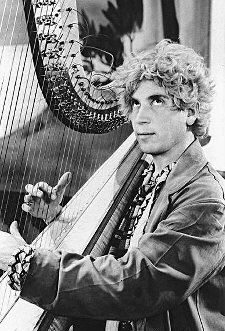| ||||||||
The Harp
By Paul Huang

The harp is a musical instrument in which the strings, sounded by plucking, run perpendicular to the soundbox, instead of parallel, like in the violin or guitar. Harps are made in three basic shapes, the arched harp, the angular harp and the more common frame harp.
The modern orchestral pedal harp is a frame harp. It is also called the concert or grand harp. They are made out of maple wood, with beautiful veneers or wood finishes added. They have 46 strings (covering six and a half octaves with seven strings per octave). The bass strings are made of wound wire while the treble strings are made of gut or nylon. The large concert grand harps are a little over six feet tall and weigh about 85 to 90 pounds. The strings of the harp resemble the notes on a piano. The "C" strings are red while the "F" strings are black. These strings are called landmarks. A harpist only uses the first four fingers of each hand to play, the little finger is never in action. The harp has a system of seven double action pedals, each pedal controlling one string in every octave. Three of the pedals are controlled by the left foot and four by the right. Each pedal has three positions which are held in place by notches in the base of the harp. These positions shorten the length of the strings forming sharps or flats. For example, the harp is tuned in C flat. When the "C" pedal is in the highest of the three notches, all the "C" strings will sound as C flat. When the pedal is in the middle notch, the notes will be C natural and in the lowest notch they will be C sharp. By using these pedals, the accomplished harpist can play the chromatic scale.
The harp is one of the oldest instruments of all. Arched harps, the most ancient of all harps were found in Egypt between 3000 and 2000 BC. Angular harps were prominent in the medieval Arabic and Persian music. Frame harps appeared in the 9th century in two versions, the Irish/Scottish one and the one that could be found in the continent. In Britain, harps played a deeply symbolic role: stone sculptures of small, portable celtic harps date back to 800 AD in Scotland. The contemporary western orchestral harp is the product of both heritage and centuries of technological innovations. They were developed in response to changing musical styles demanding a full chromatic scale. In the 17th century, small hooks were used to shorten the strings by a semitone but this sometimes made the strings go out of tune. In 1720, Celestin Hochbrucker attached the hooks to levers controlled by seven pedals, and the diatonic harp was born. In 1810, Sebastien Erard produced the modern double action harp capable of playing all major and minor keys, also called the chromatic harp.
Famous harp players of our time include, Ann Stockton (who was bestowed the "Award of Recognition for Service to the International Harp Community" by the World Harp Congress), Patricia Wooster (who is the current Chairman and CEO of the World Harp Congress), Susann McDonald (she's the top US player and produces some wonderful young performers such as Naoko Yoshino) and Carrol McLaughlin. And let's not forget the incomparable Harpo Marx who will play for you when you click his picture!
Paul is a music lover from Singapore. His interests include classical music and musical instruments (especially the French horn).
He maintains both the French Horn Resource Page and the French Hornist Webring. |
|





